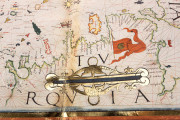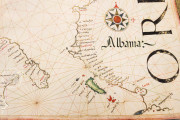This atlas is a handsome example of the work of the Portuguese cartographer Diogo Homem (d. after 1576), a member of one of the most important families of cartographers of the sixteenth century. Neither signed nor dated, the atlas has been attributed to Homem on the strength of its high artistic quality and stylistic affinity with the cartographer's signed works. It is thought to date from around 1561, probably just as Homem was settling in Venice after having worked in his native Portugal and in England. The atlas's large sheets (46 × 58 cm) feature seven brilliantly colored maps of areas in and around the Mediterranean basin and a circular calendrical diagram.
The atlas's maps detail the coastlines of the Mediterranean Sea, the Atlantic coast of Europe including the British Isles, and the Black Sea. Its landmasses are decorated with the coats of arms of ruling dynasties and painted banderoles and banners, as well as bird's-eye-view depictions of mountains and cities. The brilliant palette includes immaculately preserved gold and silver. Every compass rose glows with gold leaf and has north indicated by a red or red-and-blue fleur-de-lis.
A Luxury View of the Mediterranean
The most remarkable feature of this atlas is its artistry. The coat of arms of Castile and Aragon dominates the Iberia in the map centered on the peninsula (sheet 2). Similarly, the shields of England, Scotland, and Ireland dominate the map of northern Europe (sheet 1). Mountains are naturalistically rendered in varied shades of green and brown. As is common in the tradition of portolan charts, islands are colored: here most usually red, blue, or gold.
A Glimpse of Its Maker's Portuguese Origin
The charts follow the tradition of southern European nautical charts, with a very accurate representation of the coasts and abundant coastal place names. The names are written perpendicular to the coastline, always starting at the coast and extending inland, with the most important written in red. The coastal place names, as well as most of the labels of landmasses, are written in Gothic Textualis, with even larger names and cardinal direction names in display square capitals.
A Portuguese feature of the maps is the inclusion of a red cross marking east, the direction of Jerusalem, on the compass roses. Two cities singled out for cityscapes are Lisbon, probably Homem's first home, and Venice—with the campanile of San Marco clearly recognizable—his probable home at the time the atlas was created.
A Twentieth-Century Discovery
Diogo's atlas in Madrid was unknown to modern scholarship before it was acquired in 1970 by the Museo Naval in Madrid. Although not as extensive as Diogo's Queen Mary Atlas or his Universal Atlas, the atlas in the Museo Naval nevertheless caused an immediate sensation, and it stands as an outstanding accomplishment of mapmaking of the highest artistic quality.
We have 1 facsimile edition of the manuscript "Atlas of Diogo Homem in Madrid": Atlas del Mediterraneo de Diego Homen facsimile edition, published by AyN Ediciones, 1975
Request Info / Price


















